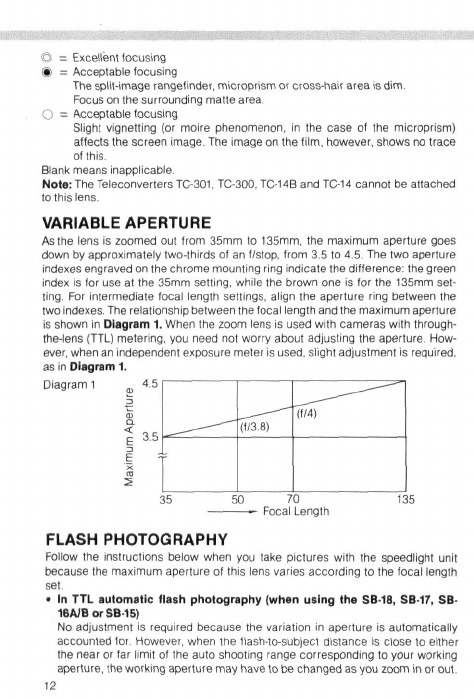
© = Excellent focusing
(§) = Acceptable focusing
The split-image rangefinder, microprism or cross-hair area is dim.
Focus on the surrounding matte area.
O = Acceptable focusing
Slight vignetting (or moire phenomenon, in the case of the microprism)
affects the screen image. The image on the
film,
however, shows no trace
of this.
Blank means inapplicable.
Note:
The Teleconverters
TC-301,
TC-300, TC-14B and TC-14 cannot be attached
to this lens.
VARIABLE APERTURE
As the lens is zoomed out from 35mm to 135mm, the maximum aperture goes
down by approximately two-thirds of an f/stop, from 3.5 to 4.5. The two aperture
indexes engraved on the chrome mounting ring indicate the difference: the green
index is for use at the 35mm setting, while the brown one is for the 135mm set-
ting.
For intermediate focal length settings, align the aperture ring between the
two indexes. The relationship between the focal length and the maximum aperture
is shown in Diagram
1.
When the zoom lens is used with cameras with through-
the-lens (TTL) metering, you need not worry about adjusting the aperture, How-
ever, when an independent exposure meter is used, slight adjustment is required,
as in Diagram 1.
Diagram
1
4.5
c 3.5
ZJ
I
;
(0
2
35 50 70 135
— Focal Length
FLASH PHOTOGRAPHY
Follow the instructions below when you take pictures with the speedtight unit
because the maximum aperture of this lens varies according to the focal length
set.
• In TTL automatic flash photography (when using the SB-18, SB-17, SB-
16AJBorSB-15)
No adjustment is required because the variation in aperture is automatically
accounted for. However, when the flash-to-subjecl distance is close to either
the near or far limit of the auto shooting range corresponding to your working
aperture, the working aperture may have to be changed as you zoom in or out.
12
(1/3.8)
(f/4)


















